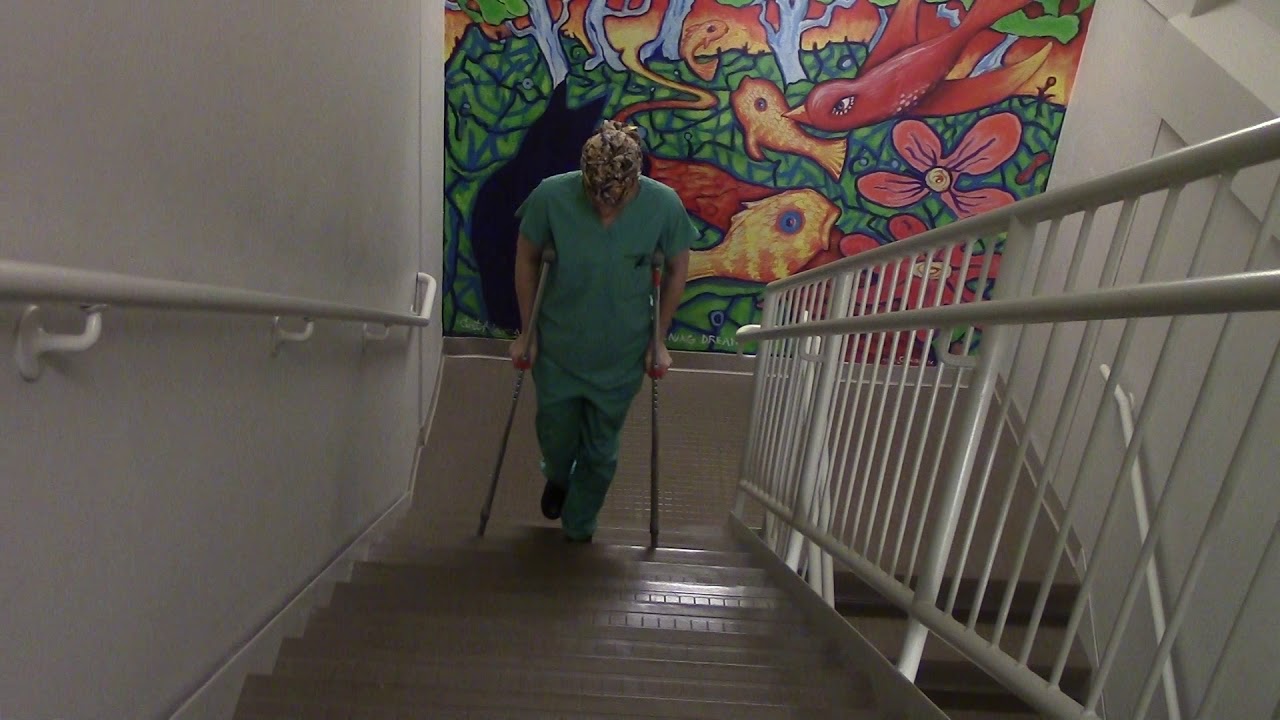

Articles
How To Get A Wheelchair Up Stairs
Modified: December 7, 2023
Learn the best techniques and methods in our informative articles on how to safely get a wheelchair up stairs. Take control and improve accessibility today!
(Many of the links in this article redirect to a specific reviewed product. Your purchase of these products through affiliate links helps to generate commission for Storables.com, at no extra cost. Learn more)
Introduction
Accessibility is a fundamental right for all individuals, regardless of their physical abilities. While ramps and elevators are common solutions for wheelchair users to navigate buildings, stairs can pose a significant challenge. The task of getting a wheelchair up stairs can be daunting, but with the right techniques and tools, it is possible to overcome this obstacle and ensure freedom of movement for wheelchair users.
In this article, we will explore various methods and options for safely and effectively getting a wheelchair up stairs. We will discuss the importance of understanding the accessibility challenge, evaluating the staircase, choosing the right type of wheelchair, ensuring user safety, and preparing for the task ahead. Additionally, we will explore the use of ramps or portable wheelchair lifts, assistance techniques, and alternative options that can facilitate the process.
It is important to note that the information provided in this article is intended as a general guide. Each situation may have unique considerations and it is recommended to consult with professionals or experts in accessibility for specific circumstances.
Now, let us delve into the intricacies of overcoming the challenge of getting a wheelchair up stairs, ensuring accessibility for all.
Key Takeaways:
- Overcoming the challenge of getting a wheelchair up stairs requires understanding the accessibility obstacles, evaluating the staircase, choosing the right wheelchair, ensuring user safety, and making thorough preparations.
- Ramps, portable wheelchair lifts, assistance techniques, and alternative options provide practical solutions for making stairs accessible to wheelchair users, promoting inclusivity and independence.
Read more: How To Get Elderly Up Stairs
Understanding the Accessibility Challenge
To effectively address the challenge of getting a wheelchair up stairs, it is important to understand the various factors that contribute to the accessibility of a building or space. Accessibility encompasses more than just physical barriers; it also includes social and attitudinal barriers that can hinder the full participation of individuals with mobility impairments.
Stairs pose a significant obstacle for wheelchair users due to the lack of ramps or elevators in certain locations. This can restrict their ability to access public spaces, buildings, or even their own homes. It is important to recognize that this limitation can have a profound impact on their independence, mobility, and overall quality of life.
Additionally, it is crucial to consider the different types of stairs that wheelchair users may encounter. Straight stairs are the most common type, but there are also spiral stairs, curved stairs, and outdoor stairs with uneven surfaces. Each type requires a unique approach and set of tools or techniques to navigate safely.
Furthermore, understanding the physical limitations of a wheelchair is essential. Wheelchairs come in various sizes and weight capacities, which can affect their maneuverability and the feasibility of certain methods to overcome stairs. It is important to consider these factors when determining the best approach for getting a wheelchair up stairs.
Lastly, it is crucial to approach the accessibility challenge with empathy and an appreciation for the unique experiences of wheelchair users. By promoting inclusivity and taking proactive measures to address accessibility barriers, we can create a more inclusive society that values and respects the rights of individuals with disabilities.
In the next sections, we will explore various methods and solutions that can help overcome the accessibility challenge of getting a wheelchair up stairs. We will discuss the evaluation of the staircase, choosing the right type of wheelchair, ensuring user safety, and preparing for the task ahead. Let’s dive deeper into these topics to find practical solutions.
Evaluating the Staircase
Before tackling the task of getting a wheelchair up stairs, it is crucial to thoroughly evaluate the staircase itself. This evaluation will help determine the feasibility of different methods and guide the selection of the most appropriate approach.
Firstly, consider the width and height of the stairs. Take measurements to ensure that the wheelchair can fit through the available space. Also, assess the height of each step to determine the level of difficulty involved in navigating the staircase. This information will help determine the type of equipment or assistance needed.
Next, inspect the condition of the stairs. Are they well-maintained, or are there any loose steps or obstructions that can pose a safety hazard? It is essential to address any potential risks or obstacles before attempting to navigate the stairs with a wheelchair.
Furthermore, consider the location and surroundings of the stairs. Are there any nearby ramps or alternate entrances that can provide an accessible route? Are there handrails or other supportive features that can assist with the ascent? Taking note of these factors will help determine the most practical and safe way to overcome the stairs.
In some instances, it may be beneficial to consult with professionals or accessibility experts who can provide valuable insights and advice based on their expertise. They may offer specific recommendations on the best approach for your particular situation, taking into consideration the unique characteristics of the staircase and your specific needs.
Evaluating the staircase thoroughly will ensure that you have a clear understanding of the challenges and potential solutions. It will guide your decision-making process and help you adopt the most suitable method for getting a wheelchair up stairs.
In the next sections, we will explore the different types of wheelchairs that are available and how to choose the right one for navigating stairs. Stay tuned for more information on this crucial aspect of making stairs accessible for wheelchair users.
Choosing the Right Type of Wheelchair
When it comes to getting a wheelchair up stairs, selecting the right type of wheelchair is essential. Different wheelchairs are designed to meet specific needs and cater to various types of terrains and obstacles, including stairs.
The two main types of wheelchairs that are commonly used for navigating stairs are manual wheelchairs and powered wheelchairs. Each type has its own advantages and considerations, depending on the individual’s strength and mobility levels.
Manual wheelchairs are lightweight and maneuverable, making them a popular choice for individuals who have sufficient upper body strength and coordination. They can be self-propelled or pushed by a caregiver or companion. Manual wheelchairs are ideal for navigating straight or narrow stairs and are often more cost-effective compared to powered wheelchairs.
On the other hand, powered wheelchairs, also known as electric or motorized wheelchairs, are operated by a battery-powered motor. These wheelchairs offer greater independence and require less physical effort to navigate. They are particularly useful for individuals with limited upper body strength or those who experience fatigue while self-propelling a manual wheelchair. Powered wheelchairs are generally more suitable for navigating complex or outdoor stairs, as well as longer distances.
When choosing a wheelchair, consider the weight and dimensions of the wheelchair, as they can impact its maneuverability and ease of use on stairs. It is essential to ensure that the dimensions of the wheelchair align with the width and height of the stairs for a safe and effective ascent.
Additionally, it is recommended to consult with healthcare professionals or rehabilitation specialists who can assess your specific needs and provide guidance on selecting the most suitable type of wheelchair. They can take into account factors such as your physical capabilities, lifestyle, and the specific challenges of the stairs you encounter.
By choosing the right type of wheelchair, you can significantly enhance your ability to navigate stairs comfortably and safely. In the next section, we will explore important considerations regarding user safety during the process of getting a wheelchair up stairs. Stay tuned!
Ensuring User Safety
When it comes to getting a wheelchair up stairs, the safety of the user should be the top priority. There are several important considerations to keep in mind to ensure a safe and secure experience during the ascent.
Firstly, it is crucial to assess the user’s physical capabilities and limitations. Understanding their strength, balance, and overall mobility will help determine the level of assistance or support they may require. If necessary, consider enlisting the help of a caregiver or companion who can provide additional assistance and ensure the user’s safety throughout the process.
Always ensure that the wheelchair is in good condition and properly maintained. Inspect the wheels, brakes, and any other mechanical components to ensure they are functioning correctly. Faulty equipment can pose a significant safety risk and should be addressed immediately.
Before attempting to navigate the stairs, it is crucial to secure any loose items or accessories on the wheelchair. This includes bags, trays, or any other objects that could get caught on the stairs or impede the user’s mobility. Make sure that the user is securely positioned in the wheelchair and that all straps or harnesses are properly fastened.
When using a manual wheelchair, it is important to employ proper body mechanics and lifting techniques to prevent any strain or injury. Bend at the knees and use your leg muscles to lift the wheelchair rather than relying solely on your back. Avoid twisting or jerking motions while ascending or descending the stairs to maintain stability.
When using a powered wheelchair, ensure that the user is familiar with the controls and knows how to operate the wheelchair safely. They should understand how to adjust the speed and navigate obstacles effectively. It is essential to follow the manufacturer’s instructions and safety guidelines to minimize the risk of accidents.
Throughout the process, communicate with the user and regularly check on their well-being. Observe for any signs of fatigue, discomfort, or distress and be prepared to take breaks if necessary. Do not rush the process and prioritize the safety and comfort of the user at all times.
By prioritizing user safety and following these important guidelines, you can significantly reduce the risk of accidents or injuries while getting a wheelchair up stairs. In the next section, we will discuss the necessary preparations before facing the challenge of navigating the stairs. Stay tuned!
Consider using a portable wheelchair ramp or a stair-climbing wheelchair to safely navigate stairs. Alternatively, ask for assistance from someone to help lift and guide the wheelchair up the stairs.
Read more: How To Get An Old Dog Up And Down Stairs
Preparing for the Task
Before embarking on the task of getting a wheelchair up stairs, it is crucial to make proper preparations to ensure a smooth and successful operation. Taking the time to plan and gather the necessary resources will help minimize potential challenges and optimize the overall experience.
The first step in preparing for the task is to gather the appropriate equipment and tools. Depending on the specific situation and the needs of the wheelchair user, this may include items such as ramps, portable wheelchair lifts, or assistive devices designed for stair navigation. Research and identify the most suitable equipment for your particular needs and ensure that they are readily available.
It is also essential to assess the physical capabilities and limitations of the individuals involved. This includes evaluating the strength and mobility of the wheelchair user, as well as the capabilities of any caregivers or companions who will be assisting. Understanding these factors will help determine the level of assistance required and allow for appropriate planning.
It is highly recommended to conduct practice sessions or simulations before attempting to navigate the actual stairs. This will familiarize everyone involved with the process and allow for adjustments and refinements as needed. Practice sessions also provide an opportunity to identify any potential challenges or areas for improvement and find the most effective methods for navigating the stairs with the wheelchair.
Prior to the actual task, ensure that the area surrounding the stairs is clear and free from any obstructions. Remove any loose objects, rugs, or debris that may pose a tripping hazard. Adequate lighting in the vicinity is also important to ensure visibility and safety during the process.
Lastly, it is important to approach the task with a positive mindset and patience. Navigating stairs with a wheelchair can be a complex and time-consuming process, and it may require multiple attempts or adjustments. Maintaining a calm and supportive atmosphere will help create a conducive environment for success and reduce stress for everyone involved.
By making the necessary preparations, obtaining the right equipment, and practicing before the actual task, you can significantly improve the outcome and ensure a safer and more efficient process of getting a wheelchair up stairs. In the next sections, we will explore different methods and options for navigating stairs with a wheelchair, including the use of ramps or portable wheelchair lifts and assistance techniques. Keep reading!
Using a Ramp or Portable Wheelchair Lift
When it comes to navigating stairs with a wheelchair, one of the most common and effective solutions is the use of ramps or portable wheelchair lifts. These equipment options provide a safe and accessible means of ascending or descending stairs, ensuring the mobility and independence of wheelchair users.
A ramp is a sloped surface that allows wheelchair users to smoothly navigate from one level to another. Ramps can be made of various materials such as aluminum, wood, or concrete and come in different lengths, widths, and inclinations. It is important to select a ramp that meets the specific needs and dimensions of the staircase.
Portable wheelchair lifts, on the other hand, are mechanical devices specifically designed to lift the wheelchair and its user to a higher or lower level. These lifts are typically lightweight and easy to maneuver, making them a convenient and versatile option for stair navigation.
Both ramps and portable wheelchair lifts can be installed temporarily or permanently, depending on the requirements and preferences of the user. Temporary installations are often ideal for periodic or temporary accessibility needs, while permanent installations are suitable for locations with regular wheelchair access requirements.
When using a ramp, it is essential to ensure that it is securely attached and stable to prevent any accidents or injuries. The gradient of the ramp should be gentle enough to allow for comfortable ascent or descent. Handrails or guardrails may also be necessary for added stability and safety.
Portable wheelchair lifts, on the other hand, provide a seamless transition between levels by lifting the wheelchair and its occupant. These lifts often have safety features such as adjustable platforms, safety brakes, and easy-to-use controls. Before using a portable wheelchair lift, familiarize yourself with the manufacturer’s instructions and safety guidelines.
It is important to note that the selection and installation of ramps or portable wheelchair lifts should be done in accordance with local building codes and accessibility regulations. Consulting with professionals or accessibility experts can help ensure compliance and optimal installation.
Using a ramp or portable wheelchair lift is a practical and effective solution for getting a wheelchair up stairs. In the next section, we will explore different assistance techniques that can be used to safely navigate stairs with a wheelchair. Stay tuned!
Utilizing Assistance Techniques
Assistance techniques can play a crucial role in safely navigating stairs with a wheelchair. These techniques involve the support and guidance of caregivers or companions to ensure the stability and safety of the wheelchair user.
One commonly used assistance technique is called the “two-person carry” or “two-person lift.” This technique involves two individuals lifting the wheelchair with the user still seated and carrying it up or down the stairs. It is essential to coordinate and communicate effectively to ensure synchronization and avoid any mishaps or accidents.
Another assistance technique is the “one-step technique” or “bump technique.” In this method, the wheelchair is lifted and bumped up or down one step at a time. This technique requires cooperation between the wheelchair user and the caregiver or companion to maintain balance and stability throughout the process.
For individuals with sufficient upper body strength and coordination, a technique called the “wheelie technique” can be used. This technique involves balancing the wheelchair on its rear wheels and using the front wheels as support while ascending or descending each step. It is important to practice and master this technique under the guidance of a healthcare professional or rehabilitation specialist.
When utilizing assistance techniques, it is crucial to prioritize communication, coordination, and safety. Ensure that clear instructions are given and understood by all parties involved. Take breaks as needed to prevent fatigue and reassess the situation regularly to make any necessary adjustments.
It is important to note that assistance techniques require adequate training, practice, and physical capability. Consulting with healthcare professionals or rehabilitation specialists can provide valuable guidance and help determine the most suitable assistance technique for your specific situation.
By utilizing assistance techniques effectively, caregivers or companions can provide essential support to wheelchair users and ensure a safe and comfortable experience while navigating stairs. In the next section, we will explore alternative options for making stairs accessible. Keep reading!
Exploring Alternative Options
In addition to ramps, portable wheelchair lifts, and assistance techniques, there are several alternative options available that can make stairs accessible for wheelchair users. These options provide additional flexibility and convenience for individuals who face challenges in navigating stairs.
One alternative option is the installation of a platform lift or stair lift. These devices are specifically designed to transport wheelchairs and their users up and down stairs. Platform lifts feature a platform on which the wheelchair can be securely placed, while stair lifts are chairs that travel along a track attached to the stairs. Both options provide a safe and efficient method of stair navigation for wheelchair users.
Another alternative option is the installation of a vertical platform lift or an inclined wheelchair lift. These lifts are typically used in outdoor settings or where a ramp or traditional lift may not be feasible. Vertical platform lifts provide vertical transportation between different levels, while inclined wheelchair lifts move along an inclined track to transport the wheelchair and user.
Additionally, some buildings or public spaces may have alternate accessible entrances with dedicated lifts or elevators. These entrances are designed to bypass the stairs altogether and provide a barrier-free access route for wheelchair users. It is important to inquire about the availability and location of such entrances when visiting a particular location.
Furthermore, advancements in technology have led to the development of innovative solutions, such as robotic stairclimbing wheelchairs. These wheelchairs are equipped with specialized mechanisms or tracks that allow them to climb stairs independently. While these options may be more costly and require careful consideration, they offer increased autonomy and independence for wheelchair users when it comes to stair navigation.
When considering alternative options, it is important to assess the specific needs and limitations of the wheelchair user, as well as the practicality and feasibility of the options in the given environment. Consulting with professionals or accessibility experts can help in exploring and implementing the most suitable alternative option.
By exploring alternative options, we can expand the accessibility options for wheelchair users and provide them with more choices for navigating stairs. In the next section, we will conclude our discussion and summarize the key points covered in this article. Stay tuned!
Read more: How To Walk Up Stairs
Conclusion
Ensuring accessibility for wheelchair users when it comes to navigating stairs is crucial for their independence, mobility, and overall quality of life. While the task of getting a wheelchair up stairs may seem challenging, there are various methods and options available to overcome this obstacle and provide a safe and accessible environment.
Throughout this article, we have discussed the importance of understanding the accessibility challenge, evaluating the staircase, choosing the right type of wheelchair, ensuring user safety, and making necessary preparations. We have also explored the use of ramps or portable wheelchair lifts, assistance techniques, and alternative options to facilitate stair navigation.
By approaching the accessibility challenge with empathy and a focus on user safety, wheelchair users can confidently overcome stair obstacles. Evaluating the staircase and selecting the appropriate equipment or assistance techniques are essential steps in ensuring a successful ascent or descent. Proper preparations and practice sessions contribute to a smoother and more efficient process.
Whether it is the use of ramps, portable wheelchair lifts, assistance techniques, or exploring alternative options, each method offers its own benefits and considerations. It is important to assess the specific needs of the wheelchair user, the characteristics of the staircase, and consult with professionals or accessibility experts to determine the most suitable approach.
Ultimately, by prioritizing accessibility and inclusivity, we can create a society that embraces the rights of individuals with disabilities. With the right resources and support, wheelchair users can navigate stairs with confidence, enabling them to fully participate in public spaces, buildings, and their own homes.
Remember, each situation may have unique considerations, and it is recommended to consult with professionals or experts in accessibility for specific circumstances. Let us work together to promote accessibility and make stairs accessible for all individuals, regardless of their mobility challenges.
Frequently Asked Questions about How To Get A Wheelchair Up Stairs
Was this page helpful?
At Storables.com, we guarantee accurate and reliable information. Our content, validated by Expert Board Contributors, is crafted following stringent Editorial Policies. We're committed to providing you with well-researched, expert-backed insights for all your informational needs.














0 thoughts on “How To Get A Wheelchair Up Stairs”